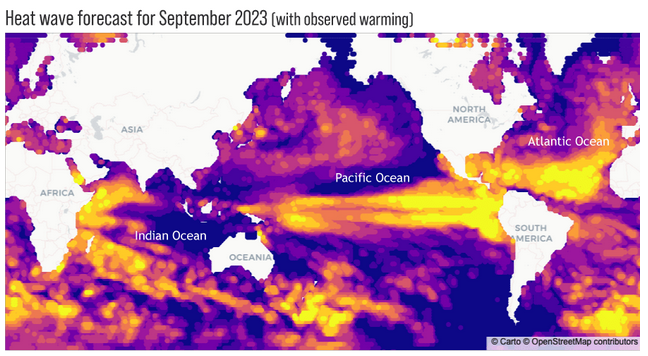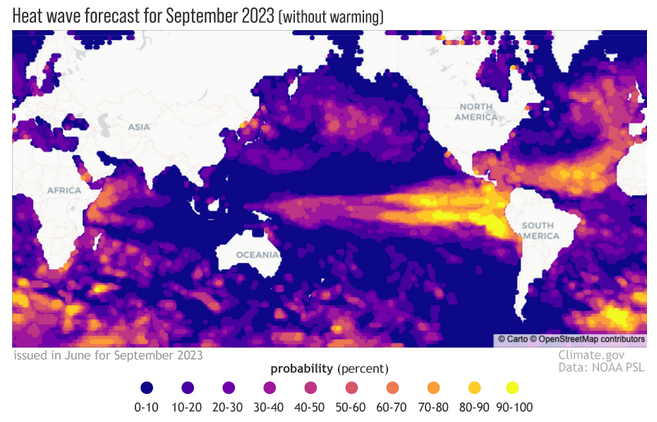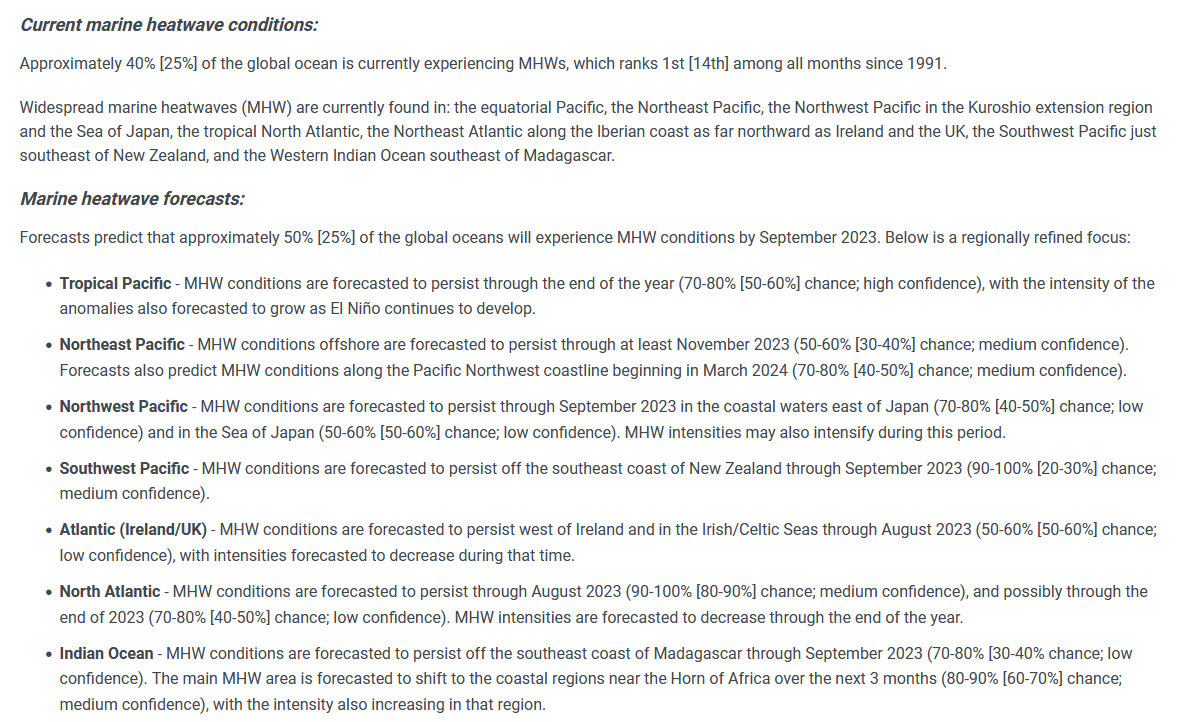 This is a somewhat confusing post that appeared in the NOAA Climate Blog which is intended to be informative and also announce a new NOAA website which you can access HERE. But we already know that the oceans are getting warmer due to Global warming. Oceans are three-dimensional. Are surface temperatures important other than the impact on the atmosphere? It is a new website but I think they have publicized it prematurely as it is IMO not fully developed. But it is a good start. They have a long way to go. But the topic is very important.
This is a somewhat confusing post that appeared in the NOAA Climate Blog which is intended to be informative and also announce a new NOAA website which you can access HERE. But we already know that the oceans are getting warmer due to Global warming. Oceans are three-dimensional. Are surface temperatures important other than the impact on the atmosphere? It is a new website but I think they have publicized it prematurely as it is IMO not fully developed. But it is a good start. They have a long way to go. But the topic is very important.
Here is the definition of a Marine Heat Wave:
“The marine heatwave (MHW) in the forecast is identified when sea surface temperature anomaly (with respect to the 1991-2020 monthly climatology) is above the MHW threshold. MHW thresholds specific to each month of the year are calculated as the 90th percentile of SST anomalies in a 3-month window (for example, for January MHWs, the 90th percentile of all December to February SST anomalies).” [Editor’s note: why 90%? That seems pretty arbitrary to me but it may be appropriate. I did not address the issue of
That is reasonable enough. In the blog article, they show the forecast for September and what it would be if we did not have Global Warming. But the counterfactual only compares the forecast to thirty or so years ago so it is a stretch to call this with and without Global Warming. But it does call attention to the problem of oceans that are warming.

First, we take a look at the current situation:

| Not sure why they use a different color scheme. Not sure why they do not show the World. And we are in El Nino. |
Then the with and without Global Warming for September of this year.

| The yellow and orange colors show what NOAA calls Marine Heat Waves. Of interest is the Atlantic Ocean which would be a major hurricane maker if not for the El Nino which blows the tops off of developing hurricanes. We expect to see the El Nino warm tongue off of Peru during an El Nino. But there are a lot of other areas that are yellow and orange but some of that is the IOD. I do not like the color coding that was used. I find the graphic confusing. I will get used to it. BTW it shows PDO Negative, unfortunately. |

| This is quite different and makes the point. But oceans are 3D and I prefer the way JAMSTEC handles it with layers of the ocean. NOAA probably does that as well but so far they have not figured out how to display it. And of course, 3D is difficult to display. I think they should show the legend with both graphics. |
Here is the discussion in the Climate.gov article:
Earlier this week, NOAA launched a new website for monitoring and forecasting the size and intensity of ocean heat waves up to a year in advance. According to the experimental forecast issued in June, 50 percent of the global oceans could experience heat wave conditions by September 2023. The forecast system also estimates how large and intense heat waves are without global warming’s influence on the ocean over the past three decades. Without the warming effect, the models predict that only 25 percent of the global ocean will be impacted by heat waves in September.
This pair of maps shows the probability that monthly average temperature in September will end up being in the warmest 10 percent (the 90th percentile) of Septembers for a given location between 1991 and 2020. The top map shows the forecast with the effects of long-term warming included, and the bottom map shows the forecast without the observed sea surface temperature trend between 1991 and 2020. Places that are darkest blue indicate a less than 10 percent chance of experiencing a heat wave; places that are brightest yellow indicate that the chance of a heat wave is greater than 90 percent.
Much more of the ocean, especially in the Indian and Pacific basins, is colored blue and purple in the bottom image, meaning that much less of the ocean is expected to experience a September heat wave when the influence of global warming over the past three decades is removed. A notable exception is the eastern tropical Pacific Ocean, where the forecast indicates a high chance of a heat wave even without long-term warming, thanks to the developing El Niño event.
In the Atlantic, meanwhile, the climate system appears to have been primed for a hot summer. While the chances of a heatwave across the Gulf of Mexico, Caribbean Sea, and tropical Atlantic would have been lower in a world without warming (bottom image), they were still pretty substantial–over 50 percent in many areas (dark pink to orange). As it is, however, the odds are greater than 70 percent across most of the region, and above 90 percent in places. (As with any forecast, the skill varies from place to place, and the uncertainty gets larger with longer lead times. The forecast page also provides maps of skill at various lead times so users can gauge how much confidence, based on past performance, underpins each forecast.)
Marine heat waves can cause mass coral bleaching, toxic algal blooms, and other heat-related disruptions of ocean ecosystems. These impacts can lead to mass die-offs of fish, marine mammals, and seabirds. Billions of dollars are lost in such events around the world each year. The new marine heatwave site can help fishing fleets, ocean managers, and coastal communities anticipate and prepare for the variety of impacts that occur during these events.
Here is some additional information from the website which can be found HERE. I think the numbers in brackets are confidence levels but maybe they are the levels without Global Warming.

–
| I hope you found this article interesting and useful. We are certainly in on the beginning of the development of this website. It is an important topic but I am not sure that they are going about it correctly. Actually, I am sure that they are not going about it correctly. But it will evolve. |
–